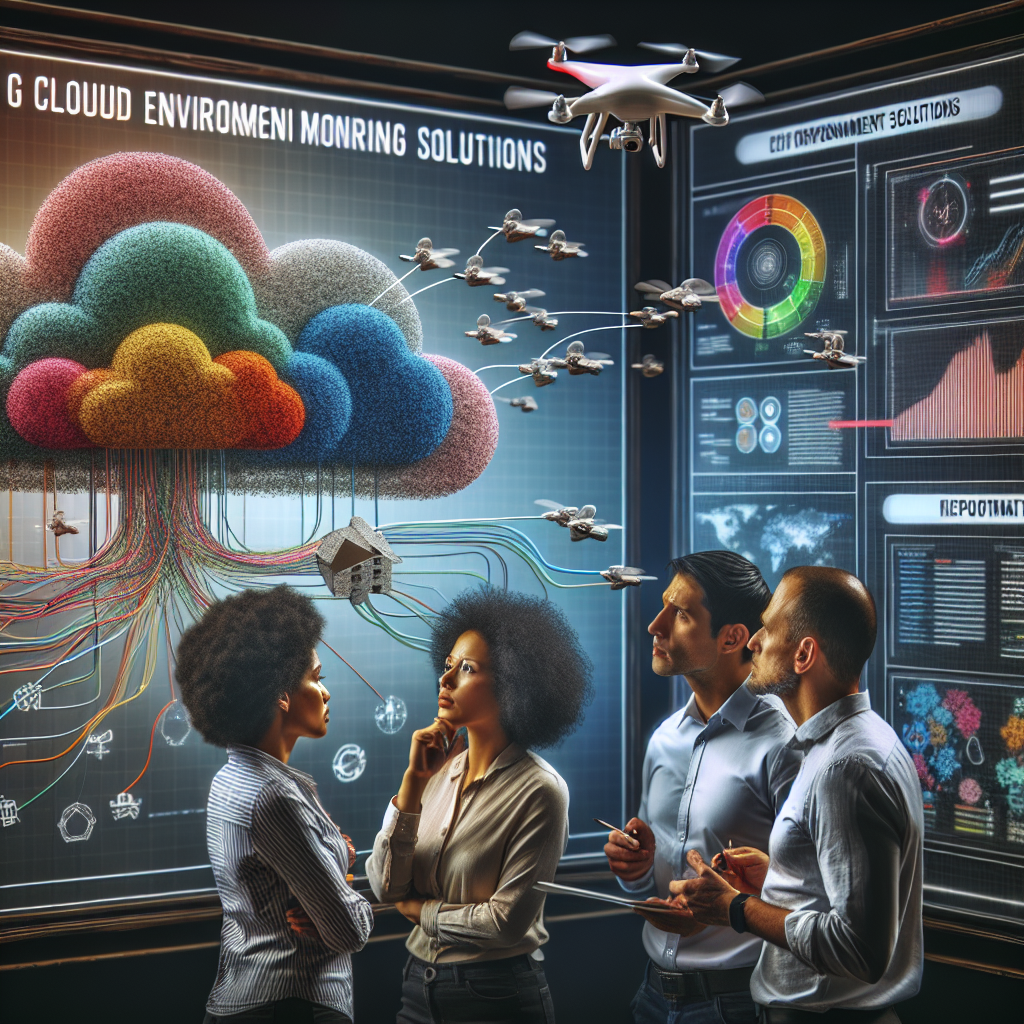In the ever-evolving landscape of technology, the importance of effective cloud environment monitoring solutions cannot be overstated. These solutions play a crucial role in ensuring the efficiency, security, and performance of cloud-based systems. By continuously monitoring and analyzing various aspects of the cloud environment such as network traffic, resource utilization, and security incidents, organizations can proactively identify and address potential issues before they escalate into major problems. This article delves into the realm of cloud environment monitoring solutions, exploring the cutting-edge tools and techniques that are reshaping the way businesses manage their cloud infrastructure. Join us on a journey to uncover the key insights and trends in this rapidly growing field.
Understanding Cloud Environment Monitoring

Cloud environment monitoring is a crucial aspect of managing and maintaining cloud infrastructures. It involves the continuous tracking and analysis of various aspects of the cloud environment to ensure optimal performance, security, and cost-effectiveness.
- Definition of Cloud Environment Monitoring
-
Cloud environment monitoring refers to the process of observing and managing the health, performance, and security of cloud-based services, applications, and infrastructure components. It involves collecting and analyzing data from various sources within the cloud environment to identify issues, trends, and opportunities for improvement.
-
Importance of Monitoring Cloud Environments
-
Monitoring cloud environments is essential for proactively identifying and addressing potential issues before they escalate into larger problems. It allows organizations to ensure the availability, reliability, and performance of their cloud services, leading to improved user experience and business continuity. Additionally, monitoring helps in optimizing resource utilization, identifying cost-saving opportunities, and ensuring compliance with security and regulatory requirements.
-
Key Metrics to Monitor in Cloud Environments
- Various metrics need to be monitored in cloud environments to gauge performance and identify potential issues. These include:
- Resource Utilization: Tracking CPU, memory, storage, and network usage to ensure efficient resource allocation and prevent bottlenecks.
- Availability and Uptime: Monitoring the availability and uptime of cloud services to ensure uninterrupted access for users.
- Security Events: Keeping an eye on security events, such as unauthorized access attempts or suspicious activities, to detect and respond to security threats promptly.
- Cost Management: Monitoring costs associated with cloud resources and services to optimize spending and prevent budget overruns.
- Compliance: Ensuring that cloud environments comply with industry regulations and internal policies through continuous monitoring and auditing.

Challenges in Cloud Environment Monitoring
-
Security Concerns in Cloud Monitoring
Security concerns in cloud monitoring are a critical challenge that organizations face when trying to ensure the confidentiality, integrity, and availability of their cloud environment. With data being stored and processed in third-party data centers, there is a heightened risk of unauthorized access, data breaches, and cyber attacks. Monitoring tools must be robust enough to detect and respond to security incidents promptly to safeguard sensitive information.
-
Scalability Issues in Monitoring Large Cloud Infrastructures
Scalability issues arise as organizations expand their cloud infrastructures to meet growing business demands. Monitoring solutions must be able to scale alongside the cloud environment without compromising performance or accuracy. Managing a large number of virtual machines, containers, and resources across multiple cloud providers requires efficient monitoring tools that can handle the volume of data generated and provide real-time insights into the health and performance of the infrastructure.
-
Compliance and Regulatory Challenges
Compliance and regulatory challenges in cloud monitoring stem from the need to adhere to industry standards, data protection regulations, and internal policies. Organizations operating in highly regulated sectors such as healthcare or finance must ensure that their cloud monitoring practices meet stringent compliance requirements. Monitoring solutions need to offer features such as audit trails, data encryption, and access controls to help organizations demonstrate compliance and mitigate legal risks associated with data privacy and security breaches.
Types of Cloud Environment Monitoring Solutions
Agent-Based Monitoring Solutions
Agent-based monitoring solutions involve deploying software agents on each virtual machine or server within the cloud environment to collect and transmit data to a centralized monitoring system. These agents are responsible for gathering performance metrics, logs, and other relevant information to provide real-time visibility into the health and status of the cloud infrastructure. By having agents embedded within each instance, organizations can achieve granular monitoring capabilities and ensure comprehensive coverage of their cloud resources. However, the overhead of managing and maintaining these agents across a large-scale environment can sometimes pose challenges in terms of scalability and resource consumption.
Agentless Monitoring Solutions
In contrast to agent-based solutions, agentless monitoring approaches rely on leveraging existing APIs and protocols provided by the cloud service providers to gather monitoring data without the need for installing additional software agents. This methodology eliminates the complexity associated with agent deployment and minimizes the performance overhead on individual instances. By utilizing APIs, organizations can extract metrics directly from the cloud platform, enabling streamlined monitoring workflows and reducing the operational burden on IT teams. While agentless monitoring offers simplicity and ease of implementation, it may have limitations in terms of data granularity and real-time visibility compared to agent-based solutions.
Hybrid Monitoring Approaches
Hybrid monitoring approaches combine the strengths of both agent-based and agentless methods to create a comprehensive monitoring strategy for cloud environments. By strategically blending these two techniques, organizations can achieve a balance between detailed, instance-level monitoring and broad, platform-level insights. This hybrid model allows for flexibility in adapting monitoring practices based on specific use cases and performance requirements. For instance, organizations can employ agent-based monitoring for critical workloads that demand deep visibility while utilizing agentless monitoring for non-intrusive, high-level monitoring of less critical resources. By leveraging a hybrid approach, organizations can optimize their monitoring capabilities to meet the diverse needs of their cloud environment.
Features to Consider in Cloud Monitoring Solutions
Cloud monitoring solutions play a crucial role in ensuring the optimal performance and security of cloud environments. When evaluating different options, there are several key features to consider to meet the specific needs of your organization:
- Real-Time Monitoring Capabilities
Real-time monitoring capabilities are essential for detecting and responding to issues promptly. These features enable continuous tracking of performance metrics, resource utilization, and potential security threats in the cloud environment. By providing instant alerts and notifications, real-time monitoring helps IT teams proactively address issues before they escalate, minimizing downtime and enhancing overall system reliability.
- Scalability and Flexibility
Scalability and flexibility are vital considerations in cloud monitoring solutions, especially for dynamic and growing environments. The ability to scale monitoring capabilities seamlessly as the infrastructure expands ensures that the system can accommodate increased workloads and data volumes without compromising performance. Additionally, flexible monitoring solutions allow for customization based on specific requirements, such as adjusting monitoring parameters or adding new metrics to track as needed.
- Integration with Cloud Service Providers
Integration with cloud service providers is another critical feature to consider when selecting a monitoring solution. Seamless integration with leading cloud platforms, such as Amazon Web Services (AWS), Microsoft Azure, or Google Cloud Platform, allows for comprehensive monitoring of all cloud resources and services within a unified dashboard. This integration simplifies management tasks, enhances visibility across the entire environment, and facilitates centralized monitoring and analysis for improved decision-making and troubleshooting processes.
Best Practices for Implementing Cloud Monitoring Solutions
Implementing cloud monitoring solutions is essential for maintaining the performance, security, and availability of cloud environments. By following best practices, organizations can effectively monitor their cloud infrastructure to ensure optimal operations and quick issue resolution.
- Setting Clear Monitoring Objectives
When implementing cloud monitoring solutions, it is crucial to establish clear monitoring objectives tailored to the organization’s specific needs and goals. Define what aspects of the cloud environment need to be monitored, such as resource utilization, network performance, security incidents, and application availability. By setting clear objectives, organizations can focus their monitoring efforts on areas critical to their operations.
- Establishing Alerts and Notifications
Setting up alerts and notifications is a key aspect of effective cloud monitoring. Organizations should configure monitoring tools to generate alerts based on predefined thresholds or anomalies in system behavior. These alerts should be sent to designated personnel or teams responsible for addressing issues promptly. By establishing proactive alerts, organizations can identify and resolve potential problems before they impact users or operations.
- Regular Performance Reviews and Updates

Regular performance reviews and updates are essential for ensuring the efficiency and accuracy of cloud monitoring solutions. Organizations should periodically review monitoring metrics to assess the performance of their cloud environment and identify areas for improvement. Additionally, it is crucial to update monitoring configurations to adapt to changes in the cloud infrastructure, such as scaling up resources or deploying new services. By conducting regular performance reviews and updates, organizations can optimize their monitoring capabilities and enhance the overall stability of their cloud environment.
Case Studies: Successful Implementation of Cloud Monitoring Solutions
Company A: Enhancing Security Through Cloud Monitoring
- Company A, a leading tech firm, successfully implemented a cloud monitoring solution to enhance its security posture.
- By utilizing real-time monitoring tools, Company A was able to detect and respond to security threats promptly.
- The cloud monitoring solution provided visibility into the company’s cloud infrastructure, enabling proactive threat mitigation.
- Through continuous monitoring and alerting mechanisms, Company A significantly reduced the risk of data breaches and unauthorized access.
- The implementation of cloud monitoring not only bolstered security but also instilled confidence in customers regarding data protection measures.
Company B: Achieving Cost Efficiency with Real-Time Monitoring
- In a bid to optimize costs, Company B adopted a cloud monitoring solution that offered real-time insights into resource utilization.
- By closely monitoring cloud resources, Company B identified underutilized assets and optimized resource allocation.
- Real-time monitoring helped Company B right-size its cloud environment, eliminating unnecessary expenses associated with over-provisioning.
- The cloud monitoring solution enabled predictive analysis, allowing Company B to forecast resource requirements accurately and adjust capacity as needed.
- As a result, Company B achieved significant cost savings while maintaining optimal performance levels in the cloud environment.
Company C: Ensuring Compliance Through Comprehensive Monitoring Strategy
- Company C, operating in a highly regulated industry, implemented a comprehensive cloud monitoring strategy to ensure compliance with industry standards.
- The monitoring solution provided visibility into data access, storage, and processing activities, helping Company C meet regulatory requirements.
- By monitoring and logging all user actions within the cloud environment, Company C could demonstrate compliance during audits.
- Automated compliance checks and policy enforcement mechanisms embedded in the cloud monitoring solution enhanced governance and risk management practices.
- Company C’s proactive approach to compliance through cloud monitoring not only met regulatory obligations but also enhanced trust among stakeholders.
FAQs: Exploring Cloud Environment Monitoring Solutions
What is a cloud environment monitoring solution?
A cloud environment monitoring solution is a comprehensive software tool or service that helps organizations monitor and manage their cloud infrastructure. It allows users to track the performance, security, and availability of their cloud-based applications and resources in real-time. This helps organizations optimize their cloud environment, reduce downtime, and ensure compliance with industry regulations.
What are the benefits of using a cloud environment monitoring solution?
There are several benefits to using a cloud environment monitoring solution. These include improved visibility into cloud infrastructure performance, enhanced security monitoring to detect and respond to potential threats, better resource utilization and cost optimization, and the ability to proactively address issues before they impact users or business operations. Overall, a cloud environment monitoring solution helps organizations maximize the benefits of their cloud investments and ensure a reliable and secure environment.
How does a cloud environment monitoring solution work?
A cloud environment monitoring solution typically works by collecting data from various sources within the cloud infrastructure, such as virtual machines, databases, storage, and networking components. This data is then analyzed in real-time to provide insights into the health and performance of the system. Alerts and notifications are generated when anomalies or potential issues are detected, allowing IT teams to quickly address and resolve any issues that may arise.
What features should I look for in a cloud environment monitoring solution?
When evaluating cloud environment monitoring solutions, it’s important to look for features such as real-time monitoring and alerting, advanced analytics for performance optimization, integration with multiple cloud providers, customizable dashboards and reports, and compliance reporting capabilities. Additionally, consider whether the solution offers automation and scalability features to support your organization’s evolving cloud infrastructure needs.